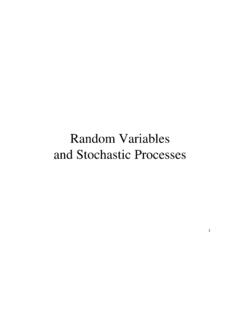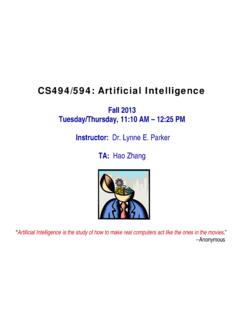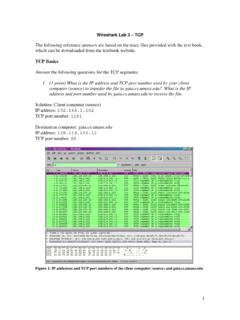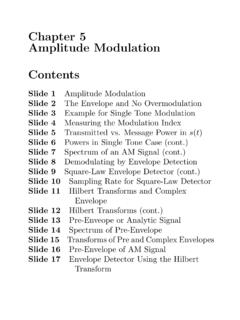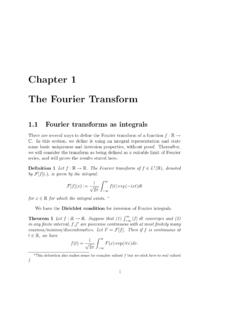Transcription of The Hilbert Transform
1 The Hilbert TransformFrank R. KschischangThe Edward S. Rogers Sr. Departmentof Electrical and Computer EngineeringUniversity of TorontoOctober 22, 20061 DefinitionThe Hilbert transformH[g(t)] of a signalg(t) is defined asH[g(t)] =g(t) 1 t=1 g( )t d =1 g(t ) d .(1)The Hilbert Transform ofg(t) is the convolution ofg(t) with the signal 1/ t. It is the responsetog(t) of a linear time-invariant filter (called a Hilbert transformer) having impulse response1/ t. The Hilbert transformH[g(t)] is often denoted as g(t) or as [g(t)] .A technicality arises immediately. The alert reader will already be concerned with thedefinition (1) as the integral is improper: the integrand has a singularity and the limits ofintegration are infinite.
2 In fact, the Hilbert Transform is properly defined as theCauchyprincipal valueof the integral in (1), whenever this value exists. The Cauchy principal valueis defined for the first integral in (1) asH[g(t)] =1 lim 0+( t t 1/ g( )t d + t+1/ t+ g( )t d ).(2)We see that the Cauchy principal value is obtained by considering a finite range of inte-gration that is symmetric about the point of singularity, but which excludes a symmetricsubinterval, taking the limit of the integral as the length of the interval approaches while,simultaneously, the length of the excluded interval approaches zero. Henceforth, wheneverwe write an integral as in (1), we will mean the Cauchy principal value of that integral (whenit exists).
3 12 Some Basic PropertiesSome obvious properties of the Hilbert Transform follow directly from the definition. Clearlythe Hilbert Transform of a time-domain signalg(t) is another time-domain signal g(t). Ifg(t) is real-valued, then so is g(t).Linearity:The Hilbert Transform is linear, , ifa1anda2are arbitrary (complex) scalars,andg1(t) andg2(t) are signals, then[a1g1(t) +a2g2(t)] =a1 g1(t) +a2 g2(t).(This follows immediately from the fact that the Hilbert Transform is the output of a linearsystem.)The Hilbert Transform of a constant signal:Note that, for any constantc, the Hilberttransform of the constant signalg(t) =cis g(t) = c= 0.
4 (See Exercise 2.) From linearityit follows thatH[g(t) +c] = g(t) + c= g(t). Thus, like an ideal differentiator, a Hilberttransformer loses dc offsets. Later we will define an inverse Hilbert Transform which canrecover the original signal up to an additive constant (in the same way that integration canundo differentiation only up to an additive constant).Time-shifting and time-dilation:Ifg(t) has Hilbert Transform g(t), theng(t t0) hasHilbert Transform g(t t0), andg(at) has Hilbert transformsgn(a) g(at) (assuminga6= 0).Convolution:The Hilbert Transform behaves nicely with respect to convolution, since[g1(t) g2(t)] = g1(t) g2(t) =g1(t) g2(t).
5 To see this, observe from the associative and commutative properties of convolution that[g1(t) g2(t)] 1 tcan be written as [g1(t) 1 t] g2(t) or asg1(t) [g2(t) 1 t].Time-derivative:The Hilbert Transform of the derivative of a signal is the derivative ofthe Hilbert Transform , ,H[ddtg(t)] =ddtH[g(t)].To see this, recall Leibniz s Integral Rule, which states thatddc b(c)a(c)f(x,c)dx= b(c)a(c) cf(x,c)dx+f(b,c)ddcb(c) f(a,c)ddca(c).2In particular, ifaandbare definite limits (independent ofc), we haveddc baf(x,c)dx= ba cf(x,c) [g(t)] =1 ddt g(t ) d =1 g (t ) d =H[g (t)],whereg (t) =ddtg(t).3 Interaction with the Fourier TransformThe signal 1/( t) has Fourier Transform j sgn(f) = j,iff>00,iff= 0j,iff<0 Ifg(t) has Fourier transformG(f), then, from the convolution property of the Fourier trans-form, it follows that g(t) has Fourier Transform G(f) = j sgn(f)G(f).
6 Thus, the Hilbert Transform is easier to understand in the frequency domain than in the timedomain: the Hilbert Transform does not change themagnitudeofG(f), it changes only thephase. Fourier Transform values at positive frequencies are multiplied by j(correspond-ing to a phase change of /2) while Fourier Transform values at negative frequencies aremultiplied byj(corresponding to a phase change of /2). Stated yet another way, supposethatG(f) =a+bjfor somef. Then G(f) =b ajiff>0 and G(f) = b+ajiff< the Hilbert Transform essentially acts to exchange the real and imaginary parts ofG(f)(while changing the sign of one of them).Energy Spectral Density:Suppose thatg(t) is an energy signal.
7 Then, since| G(f)|=|G(f)|, both G(f) andG(f) have exactly the same energy spectral density. Thus, for exam-ple, ifG(f) is bandlimited toBHz then so is G(f). It also follows that g(t) has exactly thesame energy asg(t).3 Symmetry Properties:Ifg(t) is real-valued, thenG(f) exhibits Hermitian symmetry, ,G( f) =G (f). Of course then G( f) = j sgn( f)G( f) = [ j sgn(f)G(f)] = G(f) , so G(f) also exhibits Hermitian symmetry, as (t) be a real-valued signal. Recall that ifg(t) is even (so thatg( t) =g(t)) thenG(f) ispurely real-valued while ifg(t) is odd (so thatg( t) = g(t)) thenG(f) is purely imaginary-valued. Now ifG(f) is purely real-valued then certainly G(f) is purely imaginary-valued(and vice-versa).
8 Thus ifg(t) is even, then g(t) is odd and ifg(t) is odd, then g(t) is :Ifg(t) is a real-valued energy signal, theng(t) and g(t) are see this recall that g(t), g(t) = g(t) g (t)dt= G(f) G (f)df= G(f)[ j sgn(f)G(f)] df= j|G(f)|2sgn(f)df= 0,where we have used the property that, since|G(f)|2is an even function off,|G(f)|2sgn(f)is an odd function offand hence the value of the integral is High-pass Products:Letg(t) be signal whose Fourier Transform satisfiesG(f) = 0 for|f| Wand leth(t) be a signal withH(f) = 0 for|f|<W. ThenH[g(t)h(t)] =g(t) h(t), , to compute the Hilbert Transform of the product of a low-pass signal with a high-passsignal, only the high-pass signal needs to be see this, lets(t) =g(t)h(t) so thatS(f) =G(f) H(f) =G(f) [H(f)u(f) +H(f)u( f)],whereudenotes the unit step function.
9 It is easy to see thatG(f) (H(f)u(f)) is zero iff<0; similarlyG(f) (H(f)u( f)) is zero iff>0. Thus S(f) = j sgn(f)S(f)= jG(f) (H(f)u(f)) +jG(f) (H(f)u( f))=G(f) [ jH(f)u(f) +jH(f)u( f)]=G(f) [ j sgn(f)H(f)]=G(f) H(f).4An important special case of this arises in the case of QAM modulation. Assuming thatmI(t) andmQ(t) are bandlimited toWHz, then, iffc>W, we haveH[mI(t)cos(2 fct) +mQ(t)sin(2 fct)] =mI(t)sin(2 fct) mQ(t)cos(2 fct).(3)Amplitude-modulated Signals:The Hilbert Transform of a general amplitude-modulatedsignal is given by [1]H[g(t)cos(2 fct+ )] =[g(t) cos(2 fct) t]cos(2 fct+ )+[g(t) sin(2 fct) t]sin(2 fct+ ).To see this, writeg(t) asg(t) =gL(t) +gH(t), wheregL(t), the low-pass component ofg(t), is given asgL(t) =g(t) 2fcsinc(2fct) =g(t) sin(2 fct) tandgH(t), the high-pass component ofg(t), is given asgH(t) =g(t) gL(t) =g(t) [ (t) 2fcsinc(2fct)].
10 ClearlygL(t) contains all frequency components ofg(t) from dc up to frequencyfc, whilegH(t) contains the remaining components at higher frequencies. We haveH[g(t)cos(2 fct+ )] =H[gL(t)cos(2 fct+ )] +H[gH(t)cos(2 fct+ )]=gL(t)H[cos(2 fct+ )] +H[gH(t)]cos(2 fct+ )where the second equality follows from application of the low-pass high-pass product [cos(2 fct+ )] =sin(2 fct+ ). It remains to findH[gH(t)]. This is given asH[gH(t)] =g(t) [ (t) 2fcsinc(2fct)] 1 t=g(t) [1 t 2fcsinc(2fct) 1 t](a)=g(t) [1 t 2fcsinc(fct)sin( fct)]=g(t) [1 t(1 2sin2( fct)]=g(t) cos(2 fct) t,and the main result follows directly. In the equality (a), we have used the fact thatH[sinc(t)] =sinc(t/2)sin( t/2); see Exercise Hilbert Transform :Note that[ G(f)] = ( j sgn(f))2G(f) = sgn2(f)G(f).)

